Geof Huth's Blog, page 34
March 15, 2011
Nocturnal Song
Two months ago, my friend Karri Kokko sang, and maybe primarily hummed, a quiet little song for me and passed it on to me. But I forgot to make mention of it. It's a comforting little song, something good for a winter's night, even at the end of winter, and you can find it here at The Internet Archive.
ecr. l'inf.
ecr. l'inf.
Published on March 15, 2011 20:54
March 14, 2011
One, 1, None (Fifth Draft)
See a seen.
A shape inviolate
of wonder often has possi
bilities unthought.
Numbers expressed are
an orb extended. Rays
recall an orches
tral set. The musician
can do whatnot, exploring
music.
To restrict—
district—them, a scattered
cantata, a tested symbology,
two beautiful songbirds are wrapped,
caged, &
freed, released to
extension, allowed
room, extrapola
ting that value
encompass
ed via
motions, thoughts,
a simple cusp,
intent of accident,
stasis in
glorious manifests,
englobing, arousing,
merged in, entirely
one. That becoming, an
ocean via duct:
to 3, 4—counted,
adding reality, intention,
removing it, a
subtlety.
Subtlety moving around, a
way, to convince, to see . . . .
fisher, finder, what fingers
eradicate, and foreskin,
just what oceans
encompass: beach, reach,
tense reaction to it.
Was I enraged by
seven or seventeen ways?
Relative I be, relative were
numerals: 9, 8, 7. Forever
were these
to encroach from 1
to another,
a resistant sea, ecstatic sways,
to a 1.
Waves, waves, waves,
undulants, silver that must always
be as blackened
suns, constant, radiating, cooled,
thus penumbral and
and opening a
carefully formed hole into
an expected movement. A
signifier extends every motion
(motion again). Destitute, our aim
must then reveal a
or numerous ways
(version sings slowly)
that meanings be
all our febrile reaction
feebly creates. Dawdling,
and a motion moves
on several: I am
a dispersed,
disturbed, a
lost pearl, wrecked,
taut, achingly found.
Reveal, dispel ponderous
or, say, just limpid
ore,
that sickened, waste
&
fast depth that can be little,
little more
tortured by 1 way,
our injurious way:
curtly.
_____
For a fifth year in a row, I am writing this piem, this poem based on pi, on this day of Pi, Pi Day, March 14th, wherein each word is the length in number of letters of the numerical value of its respective character in the figuring out of pi, and where each zero tells me to begin a new strophe. Last year, I ended with the words "reveal a," so this year we discover what is revealed.
ecr. l'inf.
A shape inviolate
of wonder often has possi
bilities unthought.
Numbers expressed are
an orb extended. Rays
recall an orches
tral set. The musician
can do whatnot, exploring
music.
To restrict—
district—them, a scattered
cantata, a tested symbology,
two beautiful songbirds are wrapped,
caged, &
freed, released to
extension, allowed
room, extrapola
ting that value
encompass
ed via
motions, thoughts,
a simple cusp,
intent of accident,
stasis in
glorious manifests,
englobing, arousing,
merged in, entirely
one. That becoming, an
ocean via duct:
to 3, 4—counted,
adding reality, intention,
removing it, a
subtlety.
Subtlety moving around, a
way, to convince, to see . . . .
fisher, finder, what fingers
eradicate, and foreskin,
just what oceans
encompass: beach, reach,
tense reaction to it.
Was I enraged by
seven or seventeen ways?
Relative I be, relative were
numerals: 9, 8, 7. Forever
were these
to encroach from 1
to another,
a resistant sea, ecstatic sways,
to a 1.
Waves, waves, waves,
undulants, silver that must always
be as blackened
suns, constant, radiating, cooled,
thus penumbral and
and opening a
carefully formed hole into
an expected movement. A
signifier extends every motion
(motion again). Destitute, our aim
must then reveal a
or numerous ways
(version sings slowly)
that meanings be
all our febrile reaction
feebly creates. Dawdling,
and a motion moves
on several: I am
a dispersed,
disturbed, a
lost pearl, wrecked,
taut, achingly found.
Reveal, dispel ponderous
or, say, just limpid
ore,
that sickened, waste
&
fast depth that can be little,
little more
tortured by 1 way,
our injurious way:
curtly.
_____
For a fifth year in a row, I am writing this piem, this poem based on pi, on this day of Pi, Pi Day, March 14th, wherein each word is the length in number of letters of the numerical value of its respective character in the figuring out of pi, and where each zero tells me to begin a new strophe. Last year, I ended with the words "reveal a," so this year we discover what is revealed.
ecr. l'inf.
Published on March 14, 2011 18:48
March 13, 2011
I Am Suddenly a Painter
I spent my day working in my studio-cum-office-cum-library. I created a couple dozen or so knew calliglyphs, made presentable versions of some of my better fidgetglyphs, I texted my son Tim and his girlfriend (Jackie Leung), and I painted.
In my visual poetry career, I've made only one painting before, and I didn't really finish that. It rests a few feet away from me on an easel.
I began painting yesterday, because (while watching the play Three Birds Alighting on a Field, lit by my son) I had the idea of writing a letter and poem to Billy Mavreas in the form of paintings painted with white on black. The four paintings that ensued I entitled "292. Four Acrylic Squares" and made part of my 365 ltrs project, where I write a letter in the form of a poem to a new person every day for a year, and where I also stretch the definition of "letter" and "poem" as much as I can.
Only when I had finished painting that quartet of tiny canvases (each 4 inches by 4 inches) did I realize how I should have painted them.
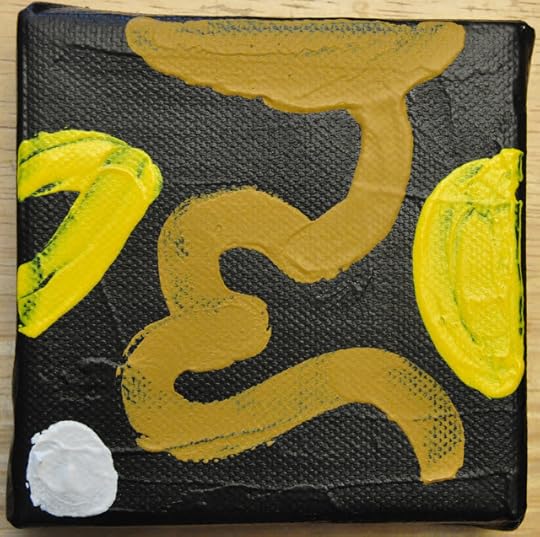 Geof Huth, "Cinnamon Tea" (13 March 2011)I made two copies of "Four Acrylic Squares," so that I'd have a copy for myself, and I had one small canvas left over, so I experimented with it and produced "Cinnamon Tea." I hadn't mastered my technique yet with this canvas, but I painted it without any brushes. The black base paint I applied with a spatula, and the colors atop it I applied straight from the tube, treating the opening of the tube as the nib of a pen.
Geof Huth, "Cinnamon Tea" (13 March 2011)I made two copies of "Four Acrylic Squares," so that I'd have a copy for myself, and I had one small canvas left over, so I experimented with it and produced "Cinnamon Tea." I hadn't mastered my technique yet with this canvas, but I painted it without any brushes. The black base paint I applied with a spatula, and the colors atop it I applied straight from the tube, treating the opening of the tube as the nib of a pen.
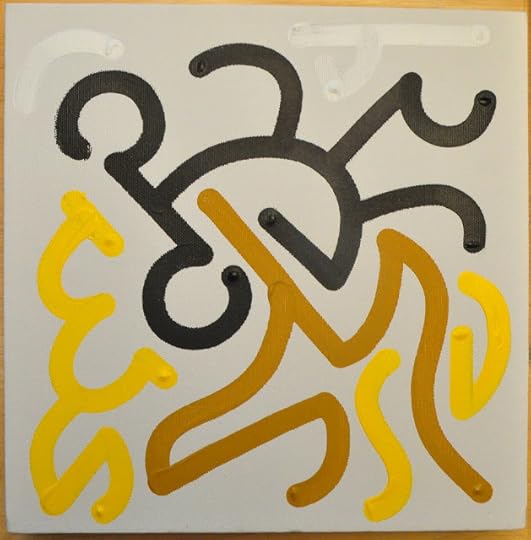 Geof Huth, "The All-Seeing Mind" (13 March 2011)
Geof Huth, "The All-Seeing Mind" (13 March 2011)
With this little discovery, I wanted to try another painting, so I pulled out a (10-by-10-inch canvas) and began to paint as if I were creating a fidgetglyph by hand. The field of play was larger, as was the nib of the "pen," but otherwise the experience was like creating a fidgetglyph. I'd found a wait to paint naturally, which was good since I'm not very handy with a brush.
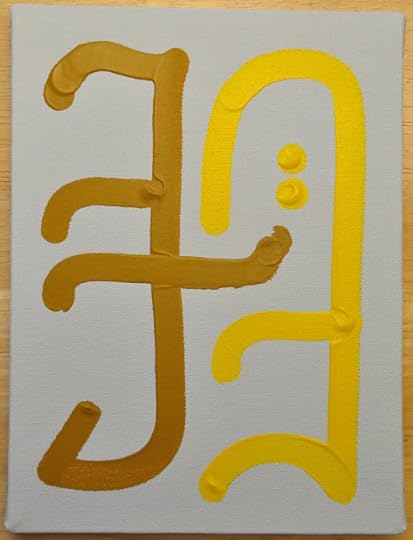 Geof Huth, "Abundance of Waiting" (13 March 2011)After completing that larger paint, I created a pair of smaller ones, one oriented portrait and the other landscape. Over the years, I'd accumulated a number of canvases in preparation for this day, so I worked my way through most of them this afternoon.
Geof Huth, "Abundance of Waiting" (13 March 2011)After completing that larger paint, I created a pair of smaller ones, one oriented portrait and the other landscape. Over the years, I'd accumulated a number of canvases in preparation for this day, so I worked my way through most of them this afternoon.
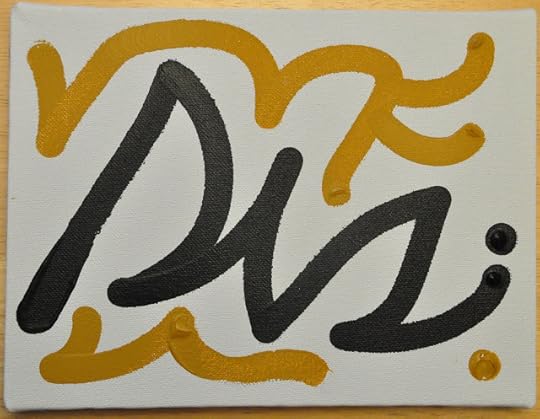 Geof Huth, "Between Above and Below" (13 March 2011)
Geof Huth, "Between Above and Below" (13 March 2011)
My one problem was a paucity of colors of paint. I had only three colors to work with (discounting white, even though I did use it once on these white canvases).
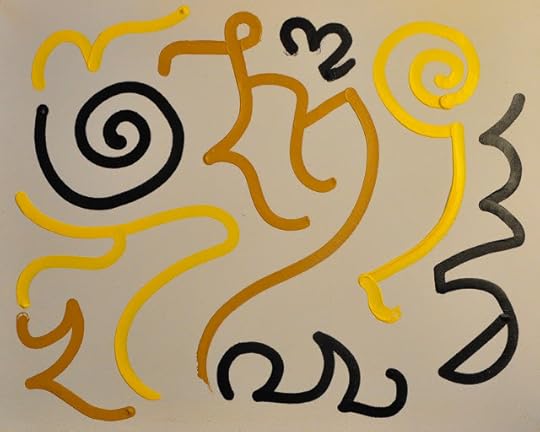 Geof Huth, "The Swirling of Being" (13 March 2011)
Geof Huth, "The Swirling of Being" (13 March 2011)
By the end of the day, after creating those dozens of calliglyphs and fidgetglyphs, I returned to painting. I had two canvases left, both relatively large, and I used one of them to create my final painting of the day.
So now I'm a painter, not a good one, not as good as Jackie, who has to paint with real skill for her work on stage sets, but I've learned to paint like a poet, like a glyphist, which is all I am.
ecr. l'inf.
In my visual poetry career, I've made only one painting before, and I didn't really finish that. It rests a few feet away from me on an easel.
I began painting yesterday, because (while watching the play Three Birds Alighting on a Field, lit by my son) I had the idea of writing a letter and poem to Billy Mavreas in the form of paintings painted with white on black. The four paintings that ensued I entitled "292. Four Acrylic Squares" and made part of my 365 ltrs project, where I write a letter in the form of a poem to a new person every day for a year, and where I also stretch the definition of "letter" and "poem" as much as I can.
Only when I had finished painting that quartet of tiny canvases (each 4 inches by 4 inches) did I realize how I should have painted them.
 Geof Huth, "Cinnamon Tea" (13 March 2011)I made two copies of "Four Acrylic Squares," so that I'd have a copy for myself, and I had one small canvas left over, so I experimented with it and produced "Cinnamon Tea." I hadn't mastered my technique yet with this canvas, but I painted it without any brushes. The black base paint I applied with a spatula, and the colors atop it I applied straight from the tube, treating the opening of the tube as the nib of a pen.
Geof Huth, "Cinnamon Tea" (13 March 2011)I made two copies of "Four Acrylic Squares," so that I'd have a copy for myself, and I had one small canvas left over, so I experimented with it and produced "Cinnamon Tea." I hadn't mastered my technique yet with this canvas, but I painted it without any brushes. The black base paint I applied with a spatula, and the colors atop it I applied straight from the tube, treating the opening of the tube as the nib of a pen. Geof Huth, "The All-Seeing Mind" (13 March 2011)
Geof Huth, "The All-Seeing Mind" (13 March 2011)With this little discovery, I wanted to try another painting, so I pulled out a (10-by-10-inch canvas) and began to paint as if I were creating a fidgetglyph by hand. The field of play was larger, as was the nib of the "pen," but otherwise the experience was like creating a fidgetglyph. I'd found a wait to paint naturally, which was good since I'm not very handy with a brush.
 Geof Huth, "Abundance of Waiting" (13 March 2011)After completing that larger paint, I created a pair of smaller ones, one oriented portrait and the other landscape. Over the years, I'd accumulated a number of canvases in preparation for this day, so I worked my way through most of them this afternoon.
Geof Huth, "Abundance of Waiting" (13 March 2011)After completing that larger paint, I created a pair of smaller ones, one oriented portrait and the other landscape. Over the years, I'd accumulated a number of canvases in preparation for this day, so I worked my way through most of them this afternoon.  Geof Huth, "Between Above and Below" (13 March 2011)
Geof Huth, "Between Above and Below" (13 March 2011)My one problem was a paucity of colors of paint. I had only three colors to work with (discounting white, even though I did use it once on these white canvases).
 Geof Huth, "The Swirling of Being" (13 March 2011)
Geof Huth, "The Swirling of Being" (13 March 2011)By the end of the day, after creating those dozens of calliglyphs and fidgetglyphs, I returned to painting. I had two canvases left, both relatively large, and I used one of them to create my final painting of the day.
So now I'm a painter, not a good one, not as good as Jackie, who has to paint with real skill for her work on stage sets, but I've learned to paint like a poet, like a glyphist, which is all I am.
ecr. l'inf.
Published on March 13, 2011 20:14
March 12, 2011
The Lens of Sighs
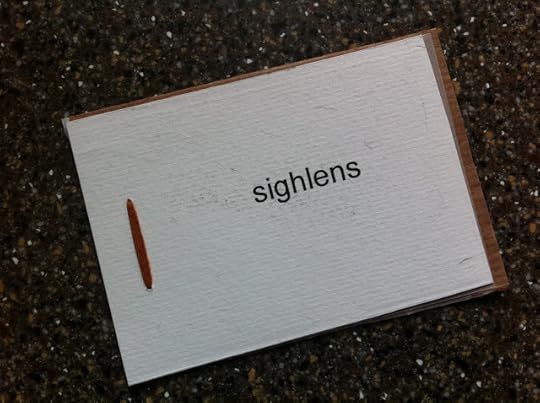
I'll be spending the day driving and watching, so I've decided to send out the smallest note about one of the smallest books of poetry I've seen recently, Jonathan Jones' sighlens.
Starting with the title, we see what is the magic of J. Jones' imagination: a respelling of "silence" becomes a way through which we see (perceive) sound itself, the word becomes not about the absence of sound, an impossibility, but about how we see the sound continuing around us even within the bounds of supposed silence.
What is most remarkable about this book, however, is that every poem (in this case, also every pwoermd) is printed recto on a different kind of paper, the paper itself, the medium of carrying forth the word into the world giving meaning to the word, for context matters and the paper is context too. For environment matters.
This book provides us a sextet of simple but effective pwoermds, words that make us stop and think, words sometimes written on crinkled paper, or on transparent paper so that we must read the word from behind to see the entire meaning.
Jonathan is the most productive and successful creator of the sequential pwoermd, the pwoermd sequence, and this, a gift to himself on his 47th birthday, is another good and enduring example of that gift. It may seem the smallest of gifts, but to my mind the small is what allows for the transformative.
Possibly available from the publisher via a note to the link below.
_____
[Jones, Jonathan]. sighlens. the sticky pages press: Brussels, 2011.
ecr. l'inf.
Published on March 12, 2011 07:18
March 10, 2011
March 9, 2011
Geof Huth, "WHAST' WASth" (9 March 2011)Came in out of th...
 Geof Huth, "WHAST' WASth" (9 March 2011)
Geof Huth, "WHAST' WASth" (9 March 2011)Came in out of the night after a day working. Came to sit down after making a fire of warmth and light. Came home after a dinner, and the cold of the night. Came in after slipping on the ice but not quite falling because I never quite fully fall.
Had a thought about finishing today. About what finishing would be like. About endings or end times, the difference wasn't quite clear.
Find myself in the middle of everything, in the middle of making, and being made, about made to be in the middle of my life even if past the center, and thinking.
Thinking it out. Thinking it through. And never quite done. Something else always to think, and the thought that comes after it.
It all continues. It all moves on, not forward, or not necessarily so. There is no forward. It is accumulation in place.
The word doesn't stay in place, doesn't hold itself still, moves in a body of words, the running blood of thought. A word is without boundary.
I write the word down, the words down, those that come to me. And I have never seen any of them before.
ecr. l'inf.
Published on March 09, 2011 19:28
March 8, 2011
When the Anagrammarian Strikes
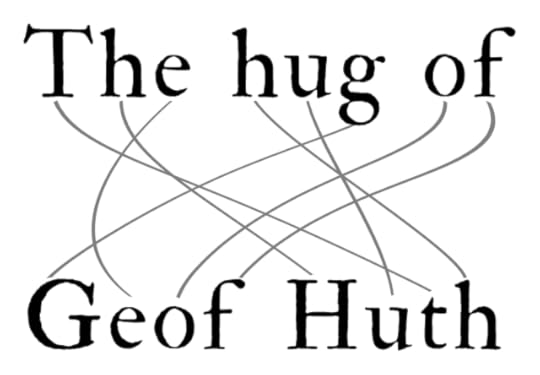 Craig Conley, "The hug of Geof Huth" (2011)Today, Craig Conley sent me the simple gift of a gif, almost a gift in name and almost my name by its name, neither of which is the significance of this gift.
Craig Conley, "The hug of Geof Huth" (2011)Today, Craig Conley sent me the simple gift of a gif, almost a gift in name and almost my name by its name, neither of which is the significance of this gift. His was the gift of an anagram stylishly put together in Craig's manner, for he is a scholar of the strange and small and wondrous, and he is often focused on the small surprises of language. His original dictionary of one-letter words was my first contact with him many years ago, and it convinced me to stop work on my own dictionary of one-letter words, which I'd begun years before.
So his gift to me today is an anagram of my name, one I should have figured out myself, since I knew all the words hid within my name, but I never put them all together at once, I never realized they perfectly anagrammized my name. So this is the gift of coincidence, but more importantly the gift of coincidence found. His creation is in the finding and in the presentation and in the presentation of it.
And now all I need to do is be known by my hugging, so that my new epithet means something more than mere coincidence.
ecr. l'inf.
Published on March 08, 2011 19:08
March 7, 2011
3 Years Since &
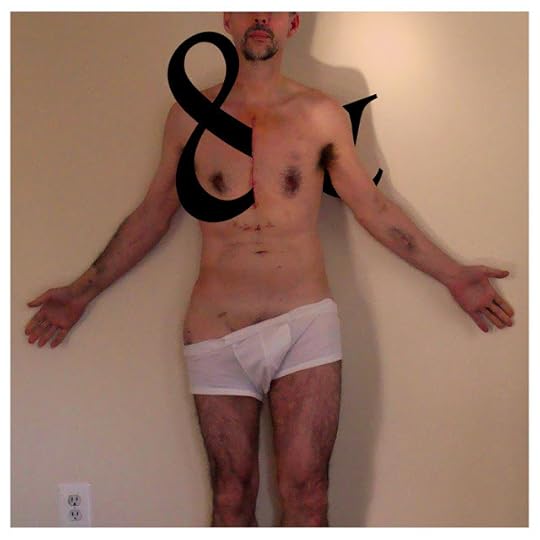 Gary Barwin, "geof copy" (date unknown)
Gary Barwin, "geof copy" (date unknown)Three years ago today, I was wheeled into surgery on a gurney so that that my heart's arteries could be given a way to move blood more expeditiously to and from my heart. On the night before that surgery, I posted this note on this blog:
Approaching midnight, I tap out with my thumbs a few words (the primary fetish of mine) as communication, memorial, and promise.I would not have remembered that this was the anniversary of this surgery except that Nancy almost had. Her recollection was that yesterday was the anniversary, but yesterday was the anniversary of the waiting for the surgery. And Nancy would not have recalled the anniversary, or she would not have mentioned it to me, except that Gary Barwin (who always surprises me, though surprise from him should be no surprise by now) sent me the visual poem above yesterday: Me + &.
At 5:30 or so tomorrow morning, I wake up. Around 7, I am wheeled towards an operating room. At 7:30, the operation to repair my broken heart begins.
I imagine tomorrow as a sequence of dreams: a corridor, looking up at flat rectangles of light, sliding from gurney to table, a shifting out of consciousness to an invisible place where I am cracked open, a waking, groggy, moving out into pain, slipping back into sleep.
Sometime tomorrow, Nancy will post word here of the disposition of my body, word of condition and time, the beginning of hope, a reformed heart, the clarion pulse of blood renewed.
And I will sleep it away.
Gary's visual poem is built upon a sort of self-portrait I've mine. I call it a self-portrait since I was the director of the photograph. I decided how to pose, where to take the picture, and at what time of the day (though my daughter Erin took the photograph). I decided what I'd be wearing (a bit more than the photo needed, but people needed at least this much).
Gary has modified the portrait a bit. The top of my head he has cut off. The color seems a little more intense, though that may be my imagination. And a huge ampersand cuts through my body.
This ampersand makes the poem Gary's work, and makes me something typographical yet human. The ampersand appears to cut through me at the point in my body where the surgeons cut me open and sawed through my sternum (which is now held together by the reknitting of bone and by wires wrapped around those bones).
I told Gary that what I like about this visual poem "is how disturbing it is, how the & cuts through me, how moving forward is to filled with grief and pain."
It is a painful life, and also beautiful for that.
ecr. l'inf.
Published on March 07, 2011 20:03
March 6, 2011
This is a Story about Acquiescence
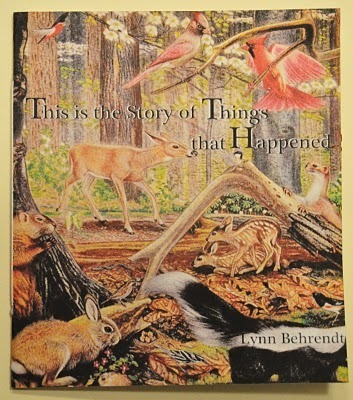
There are many ways to make words and many ways to make words work, as my friend Lynn Behrendt demonstrates in her two recent Dusie chapbooks.
This is the Story of Things that Happened
This is the story of a book. This is a story about a poem in a book. This is the story of making a chapbook big enough to hold a poem. This is not a story about Lynn Behrendt. But how could it not be?
This squarish book is adorned with an appropriated painting of a woodland scene, something Disneyish, something realistic but cartoonish simultaneously, something to tell us about the poem to come but primarily by setting it in an ironic context. Lynn's name rests in the lower right-hand corner of the cover, written across the white stripe along a skunk's back.
The poem itself is a Google-sculpted beast, something delicately constructed by texts both profound and daft collected off the Internet, and it's a wonder what Lynn can make of such texts, how she can stitch them together into something that is cohesive but also various, something that seems to inhabit every part of space at once. Somehow, but veering from the deadly serious to the almost goofy, the poem holds itself in place, telling us what stories it is going to tell us about without ever telling a story, but somehow leaving us with one:
This is the story of things that happened.
Job losses and science,
derivatives and past lives.
This is a story about giving up.
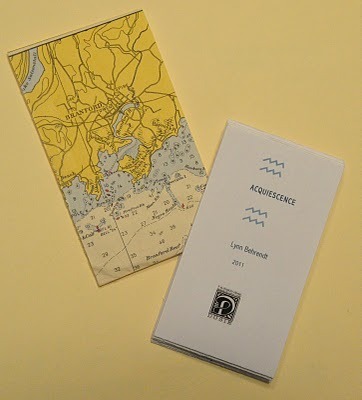
Acquiescence
The second poem, the second chapbook is a poem written in a long thin line and printed into an orihon that has pages that must, remarkably, be flipped up, rather than the left to continue the read. And, once at the bottom of the flaps of this book, we turn over the pages and continue to read the poem, leaving the reader surprised that the poem is twice as long as expected.
The folded pages of the book, which extend about five feet when fully extended, are held together with pressure-sensitive tape, which means the tape will turn the paper brown eventually, changing it into something not quite paper anymore. This internal destruction of the book seems to me appropriate for a poem that comes across as a personal one about pain, psychic pain that is hard to escape, rather than physical pain that might dissipate over time.
The book itself is comes inside a little envelope, which is made by taping together two rectangles from an atlas. On one side is a view of the Long Island Sound, showing much of the north fork of Long Island and the coast of Connecticut to its north. On the other side is a much more detailed map of Branford, Connecticut (a map so interesting to me that it led me to write a poem about it: "286. Adamic & Cartographic").
The poem "Acquiescence" is written in couplets, sometimes with exceedingly short lines, and the poem focuses on breathing and drowning, on water and air, on being a person who needs certain physical and emotional needs to be met in order to live, which may make this poems sound mawkish or sentimental. But it is a strong poem filled with a powerful sense of human emotion, which is, after all, what makes the world real.
Coda
The two poems show two realms of the work of Lynn Behrendt, two ways of making words work, and they are both worth a read. They are poems that stay with a body, become part of a body, that might not make you whole but will make you yearn for wholeness, because they are fractured poems, poems about despair, poems about living, poems about the emotional and intellectual power of words. And I have no idea if it's possible to find copies of these anywhere or if they are all distributed to colleagues and friends at the point of creation, but if you can find them, read them. Hold them in your hands, hold them close enough to your ear so you can hear them, and you will hear their hearts beating just a little too fast.
_____
Behrendt, Lynn. This is the Story of Things that Happened. Dusie, np, 2011.
Behrendt, Lynn. Acquiescence. Dusie, np, 2011.
ecr. l'inf.
Published on March 06, 2011 20:59



